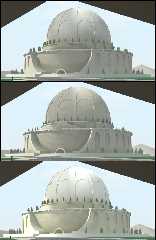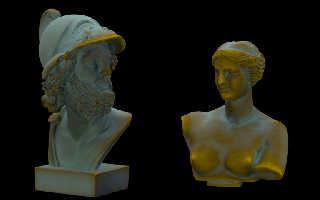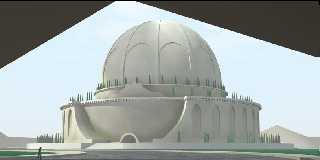 |
 |
|
 |
|
 |
|  |
|  |
|
 |
|
 |
|  |
|  |
|
 |
Hi all,
I promised to show some results of my experimentation with proximity
patterns, using my cenotaph building. The attached image shows three
results, from top to bottom:
- Patina2 macro (Rune Johansen/James Coons; 2003/2004). The pattern gives an
interesting result for the building but it renders veeeerrrryyy slowly. The
image took more than three hours to complete.
- df3prox macro (Edouard Poor; 2009). Something rather similar to Patina2.
Parsing the present df3 file took about half an hour but the render was very
fast. I believe that I have not yet got the parameters correctly as there
are still some artifacts showing.
- fastprox3 macro (Sam Benge; 2009). Very fast parsing/rendering. I added
here an adapted version of the wear pattern provided by Sam in his demo file
to get a more interesting result. The settings especially of the pigment in
the pigment_map block seems to be more tricky than with the other patterns.
I am not really sure why.
What do you think?
--
All the best,
Thomas
Post a reply to this message
Attachments:
Download 'boullee_cenotaphe_proxpat.jpg' (190 KB)
Preview of image 'boullee_cenotaphe_proxpat.jpg'

|
 |
|  |
|  |
|
 |
|
 |
|  |
|  |
|
 |
Hi
I tested Edouard's df3prox test scene with some meshes
I don't see such artifacts.
I use :
#declare resolution = <30,30,30>;
#declare num_samples = 100;
#declare sample_radius_fraction = 4;
I still have to test the others methods :-)
Marc
message de news: 4aa0da0c@news.povray.org...
> Hi all,
>
> I promised to show some results of my experimentation with proximity
> patterns, using my cenotaph building. The attached image shows three
> results, from top to bottom:
>
> - Patina2 macro (Rune Johansen/James Coons; 2003/2004). The pattern gives
> an
> interesting result for the building but it renders veeeerrrryyy slowly.
> The
> image took more than three hours to complete.
>
> - df3prox macro (Edouard Poor; 2009). Something rather similar to Patina2.
> Parsing the present df3 file took about half an hour but the render was
> very
> fast. I believe that I have not yet got the parameters correctly as there
> are still some artifacts showing.
>
> - fastprox3 macro (Sam Benge; 2009). Very fast parsing/rendering. I added
> here an adapted version of the wear pattern provided by Sam in his demo
> file
> to get a more interesting result. The settings especially of the pigment
> in
> the pigment_map block seems to be more tricky than with the other
> patterns.
> I am not really sure why.
>
> What do you think?
>
> --
> All the best,
>
> Thomas
>
>
>
>
Post a reply to this message
Attachments:
Download 'DF3Prox_Ajax_Aphrodite.jpg' (47 KB)
Preview of image 'DF3Prox_Ajax_Aphrodite.jpg'

|
 |
|  |
|  |
|
 |
|
 |
|  |
|  |
|
 |
"Thomas de Groot" <tDOTdegroot@interDOTnlANOTHERDOTnet> wrote:
> Hi all,
>
> I promised to show some results of my experimentation with proximity
> patterns, using my cenotaph building. The attached image shows three
> results, from top to bottom:
>
> - Patina2 macro (Rune Johansen/James Coons; 2003/2004). The pattern gives an
> interesting result for the building but it renders veeeerrrryyy slowly. The
> image took more than three hours to complete.
>
> - df3prox macro (Edouard Poor; 2009). Something rather similar to Patina2.
> Parsing the present df3 file took about half an hour but the render was very
> fast. I believe that I have not yet got the parameters correctly as there
> are still some artifacts showing.
>
> - fastprox3 macro (Sam Benge; 2009). Very fast parsing/rendering. I added
> here an adapted version of the wear pattern provided by Sam in his demo file
> to get a more interesting result. The settings especially of the pigment in
> the pigment_map block seems to be more tricky than with the other patterns.
> I am not really sure why.
>
> What do you think?
"Oh dear, mine looks terrible"
What are the parameters you're using (for the macro and for the textures)? It
might be able to be improved a little.
I am interested in the rendering speed, as I was hoping that, at least, would be
faster than other methods. Can you give some more timings?
Cheers,
Edouard.
Post a reply to this message
|
 |
|  |
|  |
|
 |
|
 |
|  |
|  |
|
 |
"m_a_r_c" <jac### [at] wanadoo fr> wrote:
> Hi
> I tested Edouard's df3prox test scene with some meshes
> I don't see such artifacts.
> I use :
> #declare resolution = <30,30,30>;
> #declare num_samples = 100;
> #declare sample_radius_fraction = 4;
>
> I still have to test the others methods :-)
Oh wow - those look great! Cool!
Because the DF3 pattern runs over a regular spaced grid, I suspect it works much
better on more irregularly shaped objects like those meshes, rather than regular
objects like sphere's etc. Or at least with less tuning required...
Cheers,
Edouard. fr> wrote:
> Hi
> I tested Edouard's df3prox test scene with some meshes
> I don't see such artifacts.
> I use :
> #declare resolution = <30,30,30>;
> #declare num_samples = 100;
> #declare sample_radius_fraction = 4;
>
> I still have to test the others methods :-)
Oh wow - those look great! Cool!
Because the DF3 pattern runs over a regular spaced grid, I suspect it works much
better on more irregularly shaped objects like those meshes, rather than regular
objects like sphere's etc. Or at least with less tuning required...
Cheers,
Edouard.
Post a reply to this message
|
 |
|  |
|  |
|
 |
|
 |
|  |
|  |
|
 |
web.4aa0ec379d317c83c83e2c410@news.povray.org...
>
> Oh wow - those look great! Cool!
It's your work lol, I only dropped those meshs in your test scene, tuned the
bronze texture at my taste and modified your inc file.
the defaut values declared there (as mesh_mode=false) are not overridden by
those declared in the pov file.
> Because the DF3 pattern runs over a regular spaced grid, I suspect it
> works much
> better on more irregularly shaped objects like those meshes, rather than
> regular
> objects like sphere's etc. Or at least with less tuning required...
That's what I suspected too :-)
Marc
Post a reply to this message
|
 |
|  |
|  |
|
 |
|
 |
|  |
|  |
|
 |
"Thomas de Groot" <tDOTdegroot@interDOTnlANOTHERDOTnet> wrote:
> What do you think?
Thomas, to me Edouard's has the best overall coverage and look (aside from the
rather obvious radial pattern). I really like the dome arches you've added. The
original bald dome design was rather bland. Nice work!
-Rob
Post a reply to this message
|
 |
|  |
|  |
|
 |
|
 |
|  |
|  |
|
 |
"Edouard" <pov### [at] edouard info> schreef in bericht
news:web.4aa0e4149d317c83c83e2c410@news.povray.org...
>
> "Oh dear, mine looks terrible"
Probably the settings....
>
> What are the parameters you're using (for the macro and for the textures)?
> It
> might be able to be improved a little.
#declare interpolation_mode = 2;
#declare resolution = <80,80,80>;
#declare num_samples = 60;
#declare sample_radius_fraction = 4;
//Proximity_SetBailoutValue( 30 )
#declare add_noise = true;
I used your demo pigment_pattern code without changes;
as pigment_map I used:
pigment_map {
[0.30 color rgb <0.837064, 0.814426, 0.762936>]
[0.50 color rgb <0.625, 0.5729, 0.454396>]
[0.60 color rgb <0.3854, 0.395833, 0.1875>]
}
Not being entirely sure about what I am doing, I am sure that you can
improve on this :-) However, Marc might be right about the difficluty in
tuning a regular surface.
>
> I am interested in the rendering speed, as I was hoping that, at least,
> would be
> faster than other methods. Can you give some more timings?
I did not really note those down. What I remember is that apart from the
parsing of the df3 which took about 30 minutes, the render was finished in
no more than 4 minutes on a dual core machine.
Thomas info> schreef in bericht
news:web.4aa0e4149d317c83c83e2c410@news.povray.org...
>
> "Oh dear, mine looks terrible"
Probably the settings....
>
> What are the parameters you're using (for the macro and for the textures)?
> It
> might be able to be improved a little.
#declare interpolation_mode = 2;
#declare resolution = <80,80,80>;
#declare num_samples = 60;
#declare sample_radius_fraction = 4;
//Proximity_SetBailoutValue( 30 )
#declare add_noise = true;
I used your demo pigment_pattern code without changes;
as pigment_map I used:
pigment_map {
[0.30 color rgb <0.837064, 0.814426, 0.762936>]
[0.50 color rgb <0.625, 0.5729, 0.454396>]
[0.60 color rgb <0.3854, 0.395833, 0.1875>]
}
Not being entirely sure about what I am doing, I am sure that you can
improve on this :-) However, Marc might be right about the difficluty in
tuning a regular surface.
>
> I am interested in the rendering speed, as I was hoping that, at least,
> would be
> faster than other methods. Can you give some more timings?
I did not really note those down. What I remember is that apart from the
parsing of the df3 which took about 30 minutes, the render was finished in
no more than 4 minutes on a dual core machine.
Thomas
Post a reply to this message
|
 |
|  |
|  |
|
 |
|
 |
|  |
|  |
|
 |
"Robert McGregor" <rob### [at] mcgregorfineart com> schreef in bericht
news:web.4aa0f5a69d317c834726e92b0@news.povray.org...
> Thomas, to me Edouard's has the best overall coverage and look (aside from
> the
> rather obvious radial pattern). I really like the dome arches you've
> added. The
> original bald dome design was rather bland. Nice work!
>
Thanks Robert. The original design indeed needed a bit of extra attention.
Possibly, I shall add or change some more things.
To me also Edouard's is approaching closest to what I want. Sam's seems to
be the most difficult to tune (perhaps due to my stupidity though) with or
without the extra wear given to the pigment_pattern.
Thomas com> schreef in bericht
news:web.4aa0f5a69d317c834726e92b0@news.povray.org...
> Thomas, to me Edouard's has the best overall coverage and look (aside from
> the
> rather obvious radial pattern). I really like the dome arches you've
> added. The
> original bald dome design was rather bland. Nice work!
>
Thanks Robert. The original design indeed needed a bit of extra attention.
Possibly, I shall add or change some more things.
To me also Edouard's is approaching closest to what I want. Sam's seems to
be the most difficult to tune (perhaps due to my stupidity though) with or
without the extra wear given to the pigment_pattern.
Thomas
Post a reply to this message
|
 |
|  |
|  |
|
 |
|
 |
|  |
|  |
|
 |
"m_a_r_c" <jac### [at] wanadoo fr> schreef in bericht
news:4aa0e453@news.povray.org...
> Hi
> I tested Edouard's df3prox test scene with some meshes
> I don't see such artifacts.
> I use :
> #declare resolution = <30,30,30>;
> #declare num_samples = 100;
> #declare sample_radius_fraction = 4;
>
> I still have to test the others methods :-)
>
I feel ashamed when I see this indeed :-) Maybe, as you say below, a
regular surface is more difficult to tune right...
Thomas fr> schreef in bericht
news:4aa0e453@news.povray.org...
> Hi
> I tested Edouard's df3prox test scene with some meshes
> I don't see such artifacts.
> I use :
> #declare resolution = <30,30,30>;
> #declare num_samples = 100;
> #declare sample_radius_fraction = 4;
>
> I still have to test the others methods :-)
>
I feel ashamed when I see this indeed :-) Maybe, as you say below, a
regular surface is more difficult to tune right...
Thomas
Post a reply to this message
|
 |
|  |
|  |
|
 |
From: Thomas de Groot
Subject: Re: Using a couple of proximity patterns
Date: 5 Sep 2009 05:32:07
Message: <4aa23017@news.povray.org>
|
|
 |
|  |
|  |
|
 |
OK, Edouard, it seems that I exagerated my settings. Going back to basics, I
get a much better result as the image may testify.
Using these settings now:
#declare interpolation_mode = 2;
#declare resolution = <30,30,30>;
#declare num_samples = 100;
#declare sample_radius_fraction = 2;
//Proximity_SetBailoutValue( 30 )
All other things equal. Parsing of the df3 took a couple of minutes; render
in about 2.5 minutes.
Thomas
Post a reply to this message
Attachments:
Download 'boullee_cenotaphe_adapted_df3prox.jpg' (43 KB)
Preview of image 'boullee_cenotaphe_adapted_df3prox.jpg'

|
 |
|  |
|  |
|
 |
|
 |
|  |




![]()